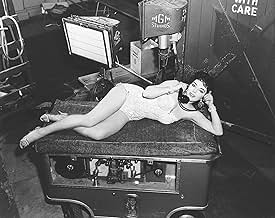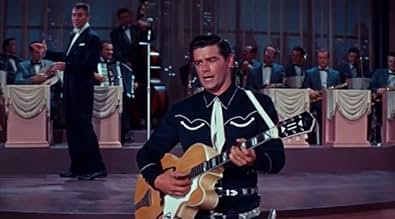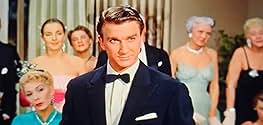CALIFICACIÓN DE IMDb
6.1/10
2.1 k
TU CALIFICACIÓN
La ex cantante de discoteca Kay Hilliard, casada 10 años y madre de una hija pequeña, es informada de que su esposo Steven tiene una aventura con la corista Crystal Allen, por lo que se va a... Leer todoLa ex cantante de discoteca Kay Hilliard, casada 10 años y madre de una hija pequeña, es informada de que su esposo Steven tiene una aventura con la corista Crystal Allen, por lo que se va a Reno para divorciarse.La ex cantante de discoteca Kay Hilliard, casada 10 años y madre de una hija pequeña, es informada de que su esposo Steven tiene una aventura con la corista Crystal Allen, por lo que se va a Reno para divorciarse.
- Dirección
- Guionistas
- Elenco
- Premios
- 2 nominaciones en total
- Dirección
- Guionistas
- Todo el elenco y el equipo
- Producción, taquilla y más en IMDbPro
Opiniones destacadas
Sort of a remake of the 1939 classic, THE WOMEN. It's more of an update with music. No matter. It stands on its own.
June Allyson stars as Kay Hilliard, a happily married woman with a trove of female friends. There's her unmarried writer friend Amanda (Ann Sheridan) and catty Sylvia (Dolores Gray), and the always-pregnant Edith (Joan Blondell). When Sylvia gets wind that Kay's husband is having a fling with a showgirl Crystal (Joan Collins), she can't wait to stir things up.
When Kay goes to Reno for a divorce she meets the oft-married Countess (Agnes Moorehead) and cabaret star Gloria (Ann Miller). When it turns out that Gloria has stolen Sylvia's husband, all hell breaks loose among the women.
Eventually Kay starts to fight back when she learns that Crystal marries her husband and starts an affair with another man.
The stars are all in fine form and Allyson gets to sing a few numbers like "Young Man with a Horn" and "Now, Baby, Now." On the down side is a horrible stage show about bananas, a terrible bit by Dick Shawn, and the nightclub opening featuring Buck Winston (Jeff Richards).
This version has men in it. There's also Leslie Nielsen, Bill Goodwin, Jim Backus, Harry James, Sam Levene, and Jonathan Hole. Co-stars include Alice Pearce as Olga, Charlotte Greenwood as Lucy, Barbara Jo Allen as Dolly the gossip columnist, and Carolyn Jones and Barrie Chase as dancers.
High points are Allyson's musical numbers, the catfight between Miller and Gray, and Allyson's slap across Collins' face that sends her earrings flying.
Gray sings the title song over the opening credits.
June Allyson stars as Kay Hilliard, a happily married woman with a trove of female friends. There's her unmarried writer friend Amanda (Ann Sheridan) and catty Sylvia (Dolores Gray), and the always-pregnant Edith (Joan Blondell). When Sylvia gets wind that Kay's husband is having a fling with a showgirl Crystal (Joan Collins), she can't wait to stir things up.
When Kay goes to Reno for a divorce she meets the oft-married Countess (Agnes Moorehead) and cabaret star Gloria (Ann Miller). When it turns out that Gloria has stolen Sylvia's husband, all hell breaks loose among the women.
Eventually Kay starts to fight back when she learns that Crystal marries her husband and starts an affair with another man.
The stars are all in fine form and Allyson gets to sing a few numbers like "Young Man with a Horn" and "Now, Baby, Now." On the down side is a horrible stage show about bananas, a terrible bit by Dick Shawn, and the nightclub opening featuring Buck Winston (Jeff Richards).
This version has men in it. There's also Leslie Nielsen, Bill Goodwin, Jim Backus, Harry James, Sam Levene, and Jonathan Hole. Co-stars include Alice Pearce as Olga, Charlotte Greenwood as Lucy, Barbara Jo Allen as Dolly the gossip columnist, and Carolyn Jones and Barrie Chase as dancers.
High points are Allyson's musical numbers, the catfight between Miller and Gray, and Allyson's slap across Collins' face that sends her earrings flying.
Gray sings the title song over the opening credits.
This remake of The Women (1939) misses the boat for two main reasons - 1. it's too nice. Joan Crawford's Crystal Allen was far more acidic than Joan Collins' sweet little version 2. it casts loads of talented musical performers - and doesn't use them! Ann Miller, Joan Blondell, Ann Sheridan, Doleres Gray - all wasted. June Allyson is miscast as Kay Hilliard, a little long in the tooth for all this.
(Incidentally interesting to see Blondell and Allyson in the same film, considering their shared marital history off-screen as successive wives to Dick Powell).
Pros - the musical numbers aren't bad, if a bit on the camp side; it features a fashion parade throughout to die for; it's colourful.
Otherwise it rips off the original, adds songs and men, and messes the whole thing up. It's watchable, but Norma, Joan, Paulette, and Rosalind will remain the standard for this particular story.
(Incidentally interesting to see Blondell and Allyson in the same film, considering their shared marital history off-screen as successive wives to Dick Powell).
Pros - the musical numbers aren't bad, if a bit on the camp side; it features a fashion parade throughout to die for; it's colourful.
Otherwise it rips off the original, adds songs and men, and messes the whole thing up. It's watchable, but Norma, Joan, Paulette, and Rosalind will remain the standard for this particular story.
No need to compare this stand-alone with the original. MGM's wardrobe department must have worked overtime. The ladies-- and there are many-- get to model all the high fashion of 1956, and some outfits are real doozies. But then this is a tell-all musical remake about sophisticated Manhattan show people from influential author Luce who certainly should know. You may need a scorecard, however, to keep up with the rotating relationships among the high class types.
I expect the film sets feminist teeth on edge now with its depiction of women as either maliciously catty (Gray & Collins) or catty as a defensive measure (Allyson, Blondell, & Sheridan). And that's when they're not chasing after men on whom it appears they're emotionally dependent. I imagine that if the movie were made today, key changes would be made.
That's not to say this Technicolor candy box isn't entertaining. It is at least campy fun, although the musical numbers are mostly forgettable. Instead, it's the characters that are irresistible, particularly Gray as the queen of acid gossip; Collins as the ruthless husband stealer; and Richards as the dude ranch stud. It's also a well-honed supporting cast, down to a blondined henchwoman Carolyn Jones. Unfortunately, it's also a rather dour June Allyson, a long way from her usual verve and sparkle.
But the high-point may well be the biggest no-holds-barred brawl between two women (Miller and Gray) that I've seen. Stand aside John Wayne and the rest of the macho brawlers because this one is worthy of the best smoke-filled bar room. I don't know if stunt doubles filled in, but somebody deserved a fat paycheck. Anyway, if you don't mind seeing women behaving badly 1950's style, this well-upholstered confection deserves a look-see.
I expect the film sets feminist teeth on edge now with its depiction of women as either maliciously catty (Gray & Collins) or catty as a defensive measure (Allyson, Blondell, & Sheridan). And that's when they're not chasing after men on whom it appears they're emotionally dependent. I imagine that if the movie were made today, key changes would be made.
That's not to say this Technicolor candy box isn't entertaining. It is at least campy fun, although the musical numbers are mostly forgettable. Instead, it's the characters that are irresistible, particularly Gray as the queen of acid gossip; Collins as the ruthless husband stealer; and Richards as the dude ranch stud. It's also a well-honed supporting cast, down to a blondined henchwoman Carolyn Jones. Unfortunately, it's also a rather dour June Allyson, a long way from her usual verve and sparkle.
But the high-point may well be the biggest no-holds-barred brawl between two women (Miller and Gray) that I've seen. Stand aside John Wayne and the rest of the macho brawlers because this one is worthy of the best smoke-filled bar room. I don't know if stunt doubles filled in, but somebody deserved a fat paycheck. Anyway, if you don't mind seeing women behaving badly 1950's style, this well-upholstered confection deserves a look-see.
I have read carefully all of the reviews posted here and I agree very much with most of what has been said. It is problematic that some of these ladies were a little bit old for their parts. It is also clear that much talent has been wasted particularly in the cases of Ann Miller who does not get to dance and Dolores Gray who does not get to sing outside of the voiceover during the titles. Most people would not even notice that the great character actoress Celia Lovsky is given literally nothing to do except appear in one of the backstage scenes and speak one or two brief lines in the bedroom scene. Some of the tiniest details have been missmanaged such as the fact that when the character of Mary holds up her hand and declaims "Jungle Red !" her fingernails are not red at all.
Of course the biggest problems are the script and the script and the script. The men and the musical numbers that have been inserted into the original storyline seem to be merely distract rather than enhance. If I try really hard and pretend that the original 1939 version does not exist then this movie can seems not so bad except that I have not really been able to convince even myself to stretch imagination that far. I also agree the one person who makes the most of of her part is Dolores Gray . Even the great Agnes Moorehead seems to be overacting dreadfully trying to make something out of nothing as the part of the Countess is woefully cut down. One thing that MGM really did manage to deliver is the look of this film. The set designers in general and the costume designer in particular really held up their end of the bargain.
But the point I really want to make is why I think this movie was even made at all. In my mind the only thing that makes any sense is that whatever deal they made with the author, Clare Booth Luce, allowed MGM to do so and they could get a few more bucks out of it which is really why most remakes are foisted upon us.
And another thing... If you compare The Opposite Sex to the latest remake- I think in 2008- it suddenly becomes brilliant! That abomination completely misses the point of the story that Miss Luce was trying to tell us. But that is another story entirely.
But the point I really want to make is why I think this movie was even made at all. In my mind the only thing that makes any sense is that whatever deal they made with the author, Clare Booth Luce, allowed MGM to do so and they could get a few more bucks out of it which is really why most remakes are foisted upon us.
And another thing... If you compare The Opposite Sex to the latest remake- I think in 2008- it suddenly becomes brilliant! That abomination completely misses the point of the story that Miss Luce was trying to tell us. But that is another story entirely.
This film has been maligned for years, mainly for including men and music in this remake of the classic 1939 version. It's true that the men don't add much to this take on the story. The musical numbers range from good (Now, Baby Now) to not so good (Dick Shawn and Jim Backus in the title number and that campy banana number.) The cast is pretty good. Joan Collins (in her first bitchy role) is practicing for her role as Alexis on "Dynasty". Charlotte Greenwood (in her last role) manages to be even more butch than Marjorie Main was in the original. Agnes Moorehead (who I love) is fun as the countess, and Sandy Descher is far more likable as "Debbie" than Virgina Weidler was as "Little Mary". Dolores Gray nails it as Sylvia Fowler. She enhances any film she is in. The 1950s decor is appropriately garish (dig those crazy purple bass fiddles!) and the print shown on VUDU is a clean, widescreen treat. This may not be quite up to the original, but on it's own terms this is a by and large entertaining film.
¿Sabías que…?
- TriviaAlthough the second Mrs. Dick Powell (Joan Blondell) was no fan of the third Mrs. Powell (June Allyson), she asked her daughter (and Allyson's stepdaughter) Ellen Powell to speak to Allyson about a role in this movie. It was Blondell's return to movies after a five-year absence, and despite the rather difficult history involving the two Mrs. Powells, all went reasonably smoothly.
- ErroresAt the end of the "Yellow Gold" musical number, two chorus boys leap up onto the banana trees for their final pose. Just as the curtain is closing, the stage-left dancer slips from his position and slides down the tree.
- Citas
Crystal Allen: When Steven doesn't like what I wear, I take it off!
[Kay slaps Crystal. Crystal smiles]
- Créditos curiososOpening credits: Manhattan Island ... A body of land consisting of four million square males-completely surrounded by women.
- ConexionesFeatured in TCM Guest Programmer: Joan Collins (2015)
- Bandas sonorasThe Opposite Sex
(uncredited)
Music by Nicholas Brodszky
Lyrics by Sammy Cahn
Performed over the opening credits by Dolores Gray
Performed during "The Psychiatrist" musical sketch with Dick Shawn, Jim Backus, Joan Collins, Carolyn Jones, Barrie Chase and Ellen Ray
Selecciones populares
Inicia sesión para calificar y agrega a la lista de videos para obtener recomendaciones personalizadas
- How long is The Opposite Sex?Con tecnología de Alexa
Detalles
Taquilla
- Presupuesto
- USD 2,834,000 (estimado)
- Tiempo de ejecución
- 1h 57min(117 min)
- Relación de aspecto
- 2.35 : 1
Contribuir a esta página
Sugiere una edición o agrega el contenido que falta






































